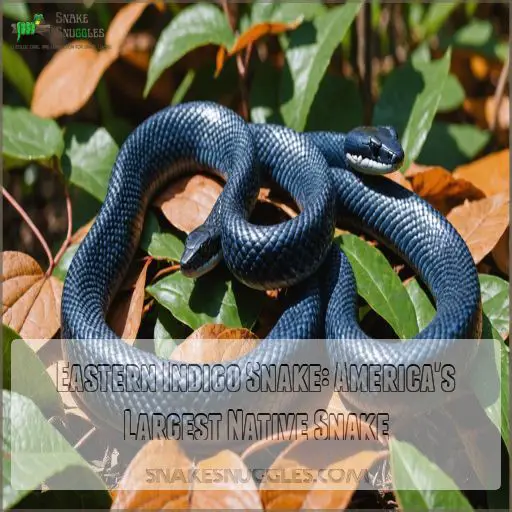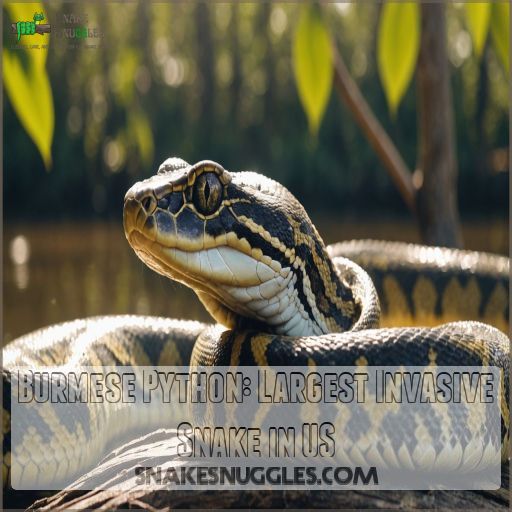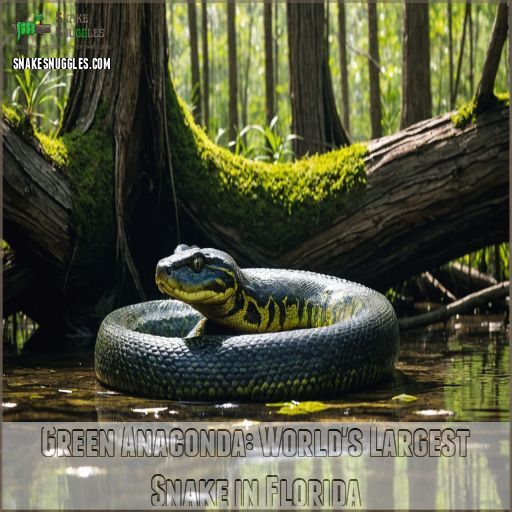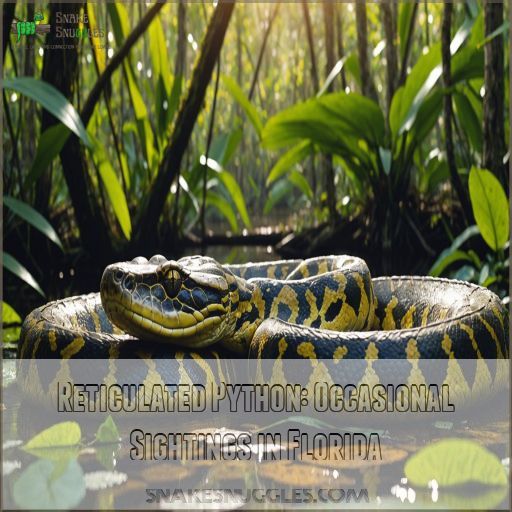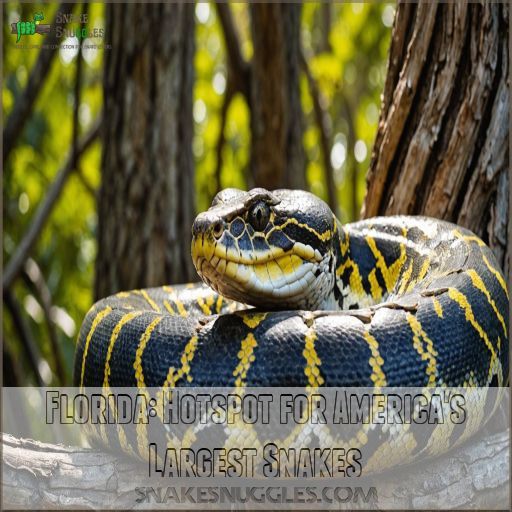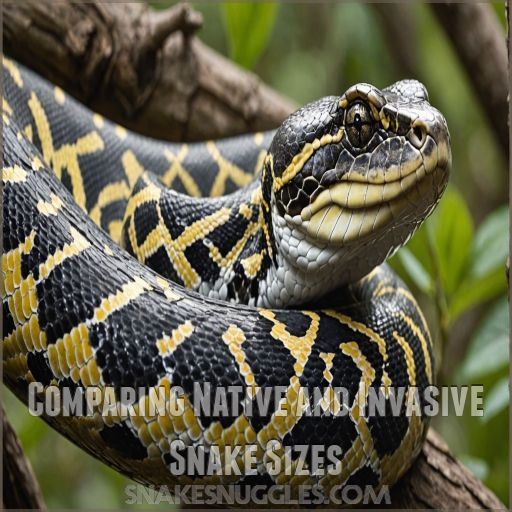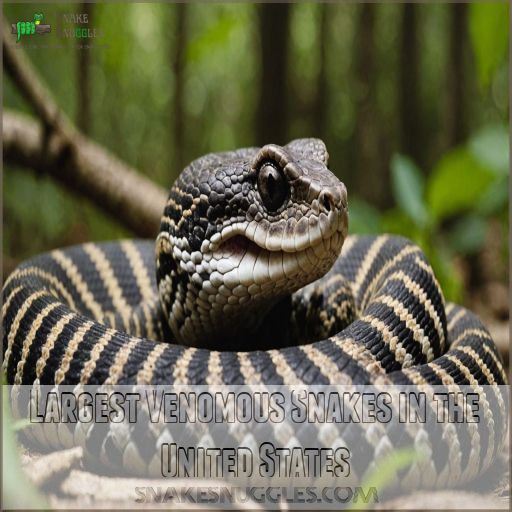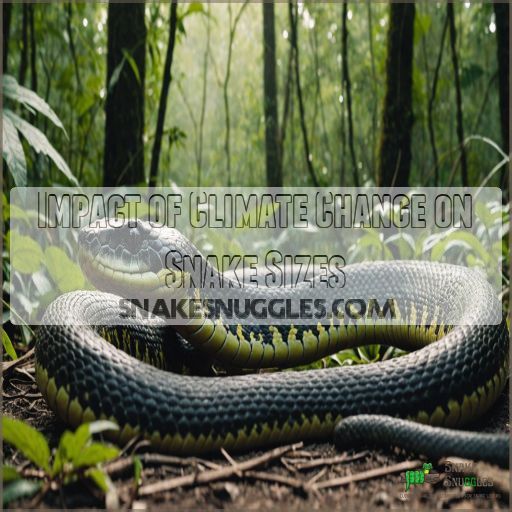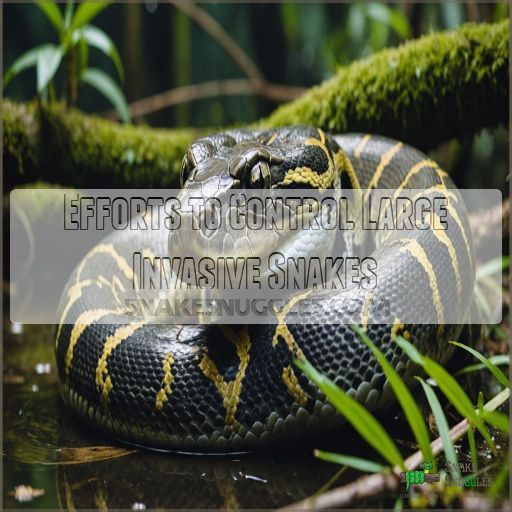This site is supported by our readers. We may earn a commission, at no cost to you, if you purchase through links.
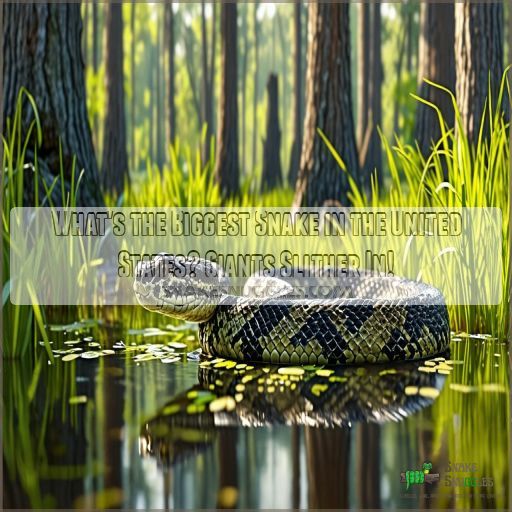 If you’re wondering about the biggest snake in the United States, meet the Eastern indigo snake. This native giant can stretch up to 9 feet long.
If you’re wondering about the biggest snake in the United States, meet the Eastern indigo snake. This native giant can stretch up to 9 feet long.
It slithers through the southeastern U.S., with bluish-black scales that shine like a new car under the sun. While it doesn’t bite, it loves to chow down on small mammals and even other snakes.
Losing ground due to urban sprawl, this snake’s less about socializing and more about surviving.
Now, if you’re thinking about those monstrous pythons in Florida, they’re a whole different story, causing quite the ruckus in local ecosystems. Curious? There’s more to uncover!
Table Of Contents
- Key Takeaways
- Eastern Indigo Snake: America’s Largest Native Snake
- Burmese Python: Largest Invasive Snake in US
- Green Anaconda: World’s Largest Snake in Florida
- Reticulated Python: Occasional Sightings in Florida
- Measuring the Giants: How Snake Size is Determined
- Florida: Hotspot for America’s Largest Snakes
- Comparing Native and Invasive Snake Sizes
- Largest Venomous Snakes in the United States
- Impact of Climate Change on Snake Sizes
- Efforts to Control Large Invasive Snakes
- Frequently Asked Questions (FAQs)
- What is the largest snake in America?
- What is the largest invasive snake in America?
- What is the largest venomous snake?
- What is the largest rattlesnake?
- How do large snakes affect local ecosystems?
- Are there any natural predators for these snakes?
- What measures are taken to track snake populations?
- How do invasive snakes spread to new areas?
- What are the safety concerns for residents?
- Conclusion
Key Takeaways
- You’ve got to meet the Eastern indigo snake, America’s largest native serpent, stretching nearly 9 feet long. This gentle giant roams the southeastern U.S. with iridescent bluish-black scales and an appetite for small mammals and other snakes. It’s more worried about urban sprawl than humans, though!
- Florida isn’t just about beaches and theme parks—it’s a snake paradise! Though invaded by massive Burmese pythons reaching 20 feet, your local natives, like the Eastern indigo, stand their ground. The Everglades serve as a five-star hotel for these slithering giants, teeming with activity and ecological chaos.
- Invasive snakes like the Burmese python are playing a wild game of "Snakes on a Plane" as they disrupt local food chains and decimate native wildlife. Imagine these crafty snakes devouring the Everglades’ native critters faster than a person eating pretzels at a ball game.
- Conservation heroes in Florida are on a mission, wrangling invasive pythons through hunts and awareness programs. They’re like modern-day snake whisperers, utilizing apps and drones to track and control these sneaky invaders, ensuring native snakes like the indigo can continue their legacy unscathed.
Eastern Indigo Snake: America’s Largest Native Snake
You might think all the biggest snakes in America are invasive, but the Eastern indigo snake proves that notion wrong.
This impressive native species can grow up to 8.5 feet long and weigh 11 pounds, making it the largest snake originally from the United States.
Physical Characteristics of the Eastern Indigo Snake
Slithering into the spotlight, the eastern indigo snake reigns as America’s largest native serpent.
You’ll be awestruck by its impressive features:
- Iridescent bluish-black scales, shimmering like a living rainbow
- Striking orange-red chin and throat, nature’s fashion statement
- Smooth scales that feel like silk under your fingers
- Males reaching a jaw-dropping 9 feet in length
- Muscular jaws that pack a powerful, non-venomous bite
This forest ruler’s size and strength make it a true giant among U.S. snakes.
Habitat and Distribution Across Southeastern States
The forest ruler’s domain stretches across the southeastern United States.
You’ll find Eastern Indigo Snakes in Florida’s diverse habitats, from pine flatwoods to cypress swamps. They’re also at home in Georgia’s coastal plain, where they rely on gopher tortoise burrows for shelter.
Sadly, these magnificent creatures are losing ground. Urban sprawl and habitat fragmentation are taking a toll, with over 5% of their Florida habitat vanishing yearly. Conservation efforts are essential to protect this native giant.
Diet and Hunting Behavior
While you might think these giants are picky eaters, eastern indigos have quite the appetite.
They’re not your average garden-variety snakes in terms of chow time. These bluish-black beauties feast on a smorgasbord of critters, from small mammals and birds to frogs, turtles, and even other snakes.
Unlike their constricting cousins, indigos use their powerful bite to overpower prey. It’s a real snake-eat-snake world out there! They have a diverse diet.
Conservation Status and Threats
Despite its impressive size, our gentle giant faces a rocky road. You’d think being the biggest native snake would make you king of the jungle, but the Eastern Indigo‘s under threat.
In fact, the Burmese Python, an invasive species, has become a major threat to native ecosystems in Florida, posing a similar risk to the Eastern Indigo’s habitat link to invasive species threat. The Reticulated Python, listed as Least Concern, also faces threats from the pet trade, a fate that could potentially befall the Eastern Indigo if conservation efforts aren’t successful.
- Urban sprawl gobbling up their homes
- Roads turning into deadly obstacle courses
- Exotic pet trade snatching them from the wild
- Invasive species muscling in on their turf
- Incomplete list
Don’t lose hope! Conservation efforts are slithering into action to give these blue-black beauties a fighting chance.
Burmese Python: Largest Invasive Snake in US
Slithering into the Everglades, Burmese pythons have become the largest invasive snakes in the U.S. These giants can grow up to 26 feet long and weigh over 200 pounds. You’d be hard-pressed to find them, though – they’re masters of camouflage!
These sneaky serpents have caused quite a stir in Florida’s ecosystem, gobbling up everything from tiny songbirds to full-grown deer.
Let’s break down the python problem:
| Characteristic | Impact | Control Measure |
|---|---|---|
| Size | Outcompetes natives | Python Patrol Training |
| Diet | Decimates prey populations | Florida Python Challenge |
| Breeding | Rapid population growth | Contractor removals |
| Habitat | Adapts to various environments | Research for better detection |
| Origin | Southeast Asia | Exotic Pet Amnesty Program |
Want to join the python-busting squad? You can report sightings through the IveGot1 app or by calling 888-IVE-GOT1. Happy hunting!
Green Anaconda: World’s Largest Snake in Florida
You might be surprised to learn that the world’s largest snake species, the green anaconda, has been spotted in Florida’s Everglades.
These massive constrictors can grow up to 22 feet long and weigh a whopping 500 pounds, dwarfing even the largest native snakes in the United States, which makes them the largest constrictors.
Size Comparison With Native US Snakes
Green anacondas, now spotted in Florida, dwarf our native snakes .
You’ll be amazed at how these giants measure up:
- Length: Up to 29 feet, nearly triple the eastern indigo snake’s 8 feet
- Weight: A whopping 550 pounds, compared to the indigo’s 11 pounds
- Girth: 12 inches in diameter, making them as thick as your thigh
These South American behemoths are turning heads and raising eyebrows in the Sunshine State’s snake scene.
Habitat Preferences in the Everglades
The Everglades’ lush landscape offers a paradise for the green anaconda.
You’ll find these giants lurking in shallow waters, where they blend seamlessly with the verdant vegetation. They’re drawn to areas with ample prey and minimal human interference.
With a knack for aquatic living, these serpents thrive in the park’s 1.5 million acres of swamps and slow-moving rivers.
It’s like they’ve found their own slice of snake heaven!
Potential Ecological Impact on Florida’s Ecosystem
As these giants slither into Florida’s ecosystem, you’re witnessing a potential ecological nightmare unfold.
Green anacondas, along with Burmese pythons, such as the popular pet Burmese python that require a spacious enclosure to accommodate their adult size The Best Large Snakes for Pets, and other large constrictors, are throwing the Everglades’ delicate balance into chaos.
They’re gobbling up native species like wood storks and Key Largo wood rats, leaving a trail of declining populations in their wake. It’s like nature’s own version of Pac-Man, with these snakes munching through the food web and disrupting the ecosystem’s harmony.
Challenges in Population Control and Management
Slithering into Florida’s ecosystem, the green anaconda poses a colossal challenge for wildlife managers.
You’re facing an uphill battle with these giants, as ethical considerations and funding challenges complicate control efforts.
Public perception is a double-edged sword; some see them as fascinating, while others view them as a threat.
Data collection and community engagement are essential, but it’s like finding a needle in a haystack when tracking these elusive snakes.
Nature enthusiasts, your help is needed to tackle this serpentine puzzle!
Reticulated Python: Occasional Sightings in Florida
Ever wondered what’s lurking in Florida’s lush landscapes? You might be surprised to spot a reticulated python, one of the world’s longest snakes, occasionally slithering through the Sunshine State. These stunning giants, with their intricate net-like patterns, aren’t native to Florida but have made occasional appearances, likely due to the exotic pet trade.
While they’re not as prevalent as their Burmese cousins, reticulated pythons pose potential threats to local ecosystems.
While not the largest snake in the world by weight, a boa constrictor, another massive snake species, can grow to impressive lengths.
Conservation efforts are in full swing, with the FWC encouraging humane handling and reporting of these impressive reptiles. If you’re feeling adventurous, you can even join the python hunting challenge – just ask Charlie Dachton, who bagged 41 pythons in one hunt!
Remember, if you spot one, report it using the IveGot1 app.
Measuring the Giants: How Snake Size is Determined
Ever wondered how scientists measure those massive snakes you’ve heard about?
Measuring giant snakes isn’t as simple as using a ruler – it’s a tricky process that involves special techniques, safety precautions, and careful record-keeping to guarantee accuracy.
It guarantee accuracy is needed in this type of work.
Length Measurement Techniques
For accurate snake measurement, you’ll need to get up close and personal with these slippery customers, like the boa constrictor which can grow up to 13 feet in length. Factors such as genetics, diet, and environmental conditions can influence a snake’s growth rate, particularly in terms of their food availability needs
.
It’s not as simple as stretching out a tape measure! Here are some techniques scientists use to size up these serpentine giants:
- Plexiglass box method: Press the snake against a clear surface
- String outlining: Trace the snake’s body with a string
- Digital analysis: Use software to measure snakes in photographs
- Flexible tape measure: For larger snakes, but positioning can vary results
Remember, accuracy is key, safety comes first!
Weight and Girth Considerations
You might think length is everything when sizing up snakes, but girth and weight pack a punch too! Let’s get into the hefty world of snake measurements.
We’ll explore how experts estimate a snake’s body mass index and use girth measurement techniques to get the full picture. After all, in the case of giant snakes, it’s not just about being long and lean!
| Measurement | Technique | Importance |
|---|---|---|
| Girth | Flexible tape | Indicates body mass |
| Weight | Scale or formula | Reflects overall size |
| BMI | Weight/Length^2 | Health assessment |
| Diameter | Calipers | Cross-section size |
| Volume | Water displacement | Total body size |
Challenges in Accurately Measuring Large Snakes
Measuring these slithery giants isn’t a walk in the park!
Limited access and elusive behavior make it a real serpentine challenge .
You might think it’s as simple as stretching out a tape measure, but these crafty critters don’t exactly line up for a photo op.
Weight estimation becomes a guessing game, and length variations can leave you scratching your head.
It’s like trying to measure a wet noodle with chopsticks!
Record-keeping and Verification Processes
Once you’ve wrangled that giant snake, it’s time to make it official!
Data collection is key in the realm of snake sizing. Experts use standardized measurement methods to guarantee accuracy. They’ll often sedate the snake for precise measurements – talk about a scaly nap time!
Official records require thorough verification protocols, including multiple witnesses and video evidence. It’s like CSI: Serpent Edition, with every scale under scrutiny!
Florida: Hotspot for America’s Largest Snakes
You’ll find Florida’s not just for retirees and theme parks—it’s a snake paradise too.
The Sunshine State’s warm climate and lush habitats have made it a hotspot for some of America’s biggest snakes, both native giants like the eastern indigo and invasive behemoths like the Burmese python.
Climate and Habitat Suitability
Florida’s climate is a snake’s paradise, offering a smorgasbord of conditions for these slithering giants. The Sunshine State‘s warm, humid weather and diverse ecosystems create a perfect storm for both native and invasive species to thrive.
- Year-round warmth supports continuous growth
- Abundant prey supports impressive sizes
- Varied habitats provide hiding spots
As climate change reshapes landscapes, these reptilian behemoths might just expand their territories, giving new meaning to "snake in the grass" .
Exotic Pet Trade Influence
The exotic pet trade has turned Florida into a slithering hotspot for America’s largest snakes.
You might be surprised to learn that 85% of non-native reptiles and amphibians in the Sunshine State arrived via this trade. It’s like a reptilian revolving door!
Responsible pet ownership is vital, as release consequences can be devastating.
Exotic pet trade regulations and trade monitoring are essential to prevent these scaly giants from wreaking havoc on local ecosystems, highlighting the importance of preventing these scaly giants.
Everglades as an Ideal Environment
Why do snakes love the Everglades? It’s like a five-star hotel for our slithery friends.
You’ve got warm, muddy marshes that feel like a cozy blanket (Source). There’s an all-you-can-eat buffet of unsuspecting critters.
Plus, it’s a python’s paradise for breeding. It’s no wonder these invasive species have made themselves at home, tipping the ecosystem balance.
The Everglades’ unique habitat has become a hotspot for America’s largest snakes, making it a true invasive species haven.
Impact on Native Wildlife Populations
Imagine a world where the food chain’s been turned upside down.
That’s what’s happening in Florida’s wild spaces. Giant snakes, like Burmese pythons, are wreaking havoc on native wildlife.
They’re gobbling up everything from tiny marsh rabbits to deer, disrupting predator-prey dynamics .
You’d be hard-pressed to find raccoons or opossums these days – their populations have plummeted by over 98% since 1997.
It’s a real-life monster movie, and our local critters are the unwitting stars.
Comparing Native and Invasive Snake Sizes
You might be surprised to learn that the biggest snakes in the U.S. aren’t always the ones that have been here the longest.
When you compare our native serpents to the newcomers, you’ll find that some invasive species are giving our homegrown giants a run for their money in the size department.
Eastern Indigo Snake Vs. Burmese Python
Two giants slither in the Sunshine State: the native Eastern Indigo and the invasive Burmese Python. You’ll be amazed by their differences! The Indigo, a non-venomous charmer, can reach 8 feet long. Meanwhile, the Python’s a real stretch, growing up to 20 feet!
Let’s compare these serpentine superstars:
- Size: Indigo (8 ft) vs Python (20 ft)
- Origin: Native vs Invasive
- Diet: Varied vs Mammal-heavy
- Conservation: Threatened vs Controlled
These snakes are worlds apart, but they’re both turning heads in Florida’s wild kingdom!
Green Anaconda Vs. Native Constrictors
Several impressive constrictors slither through Florida’s swamps, but how do they measure up?
The green anaconda, a formidable invader, dwarfs native species like the eastern indigo snake. While anacondas can reach a whopping 15 feet, our homegrown champs top out around 9 feet.
It’s like a school bus to a compact car! This size difference raises concerns about the anaconda’s potential impact on Everglades ecology and native predator dynamics.
Size Variations Within Species
You might think a snake’s a snake, but size can vary wildly within species.
Take the eastern indigo, America’s longest native snake. While some stretch to a whopping 9 feet, others might be several feet shorter.
It’s like comparing a Great Dane to a Chihuahua! Genetic factors play a role, but diet and location can make a big difference too.
You’d be amazed how much a snake’s size can change based on its zip code!
Factors Influencing Growth in Different Environments
Snakes are nature’s ultimate shape-shifters, growing to fit their surroundings like a hand in a glove.
Let’s slither into the factors that make some snakes giants and others pint-sized. It’s not just genetics; the environment plays a huge role in determining a snake’s ultimate size.
- Buffet-style food availability (all-you-can-eat rodents, anyone?)
- A smorgasbord of prey diversity (variety is the spice of life!)
- Climate influence (warmer temps = faster metabolism)
- Habitat diversity (more niches = more opportunities to grow)
Largest Venomous Snakes in the United States
You might think the biggest snakes in the U.S. are all constrictors, but venomous giants like the Eastern Diamondback Rattlesnake and Timber Rattlesnake pack a powerful punch too.
These formidable serpents may not reach the lengths of their non-venomous cousins, but they’re still impressive specimens that command respect in the wild.
Eastern Diamondback Rattlesnake
While we’ve explored giants like pythons, let’s rattle things up with America’s venomous heavyweight champion.
The Eastern Diamondback Rattlesnake packs a powerful punch, reaching lengths up to 8 feet. These burly beauties prefer scrublands and coastal forests, where they feast on rabbits and rodents [24).
But don’t let their size fool you – they’re masters of camouflage, blending in like pros in pine flatwood habitats.
Timber Rattlesnake
Slithering through deciduous forests, the timber rattlesnake packs a powerful punch.
This venomous giant, stretching up to 5 feet long, calls rugged terrain home. You’ll find them basking on rocky outcrops, blending in like nature’s chameleons.
They’re not picky eaters, chowing down on mice, shrews, and even the occasional bird. But watch out, they have a powerful punch.
Urban sprawl and road traffic are giving these serpents a run for their money.
Comparison With Non-venomous Giants
Dwarfing their venomous cousins, non-venomous giants rule the roost in the U.S. snake world.
You’d be amazed at how these constrictors stack up:
- Eastern Indigo Snake: America’s largest native, reaching 8 feet
- Burmese Python: Invasive behemoth, tipping scales at 200+ pounds
- Green Anaconda: World’s heftiest, occasionally spotted in Florida
- Reticulated Python: Rare visitor, potentially longest snake globally
- Eastern Diamondback Rattlesnake: Venomous champion, maxing out at 8 feet
Talk about a snake-eat-snake world! These giants are reshaping ecosystems faster than you can say "ssssss.
Impact of Climate Change on Snake Sizes
You might be surprised to learn that climate change could make snakes even bigger than they’re now.
As temperatures rise and habitats shift, some snake species might find more food and grow larger, potentially turning your backyard into a real-life "Snakes on a Plane" scenario.
Temperature Effects on Growth Rates
As temperatures rise, you’ll see snakes growing faster and larger.
Climate change is turning up the heat on snake metabolism, pushing them closer to their best temperatures for growth .
But there’s a catch – snakes have growth limits, and too much heat can be stressful.
It’s like a Goldilocks situation: not too cold, not too hot, just right for optimal incubation temperatures for California king snake size how big do they get ideal snake growth
.
This warming trend could lead to some seriously supersized serpents slithering around, resulting in supersized serpents.
Food Availability and Prey Size
Ever wondered how a snake’s dinner affects its waistline?
Well, it’s not just about portion control! Climate change is shaking up the snake-eat-snake world, influencing prey abundance and availability.
You’ll find these slithery giants adapting their diets faster than you can say "supersized serpent."
As prey sizes shift, snakes face new size limitations and food competition. It’s a real-life game of "Hungry Hungry Pythons" out there!
Habitat Expansion for Large Snake Species
You’ve got to hand it to these slithery giants – they’re making themselves right at home!
Climate change is rolling out the red carpet for large snake species, expanding their habitat suitability.
As temperatures rise, you’ll find these cool customers venturing into new territories.
This invasive species impact is shaking up predator-prey dynamics, leaving conservationists scratching their heads.
It’s like Mother Nature’s playing a game of "Snake," and we’re all trying to keep up!
Potential Future Size Trends
Imagine snakes getting supersized! Climate change might be cooking up a recipe for giant serpents.
As temperatures rise, you’ll see food availability trends shifting, potentially leading to larger prey.
This snake-size evolution isn’t just a tall tale – it’s backed by science.
Habitat expansion effects could give these scaly behemoths more room to grow, while genetic influence affects their ability to adapt. It’s like "Snake," but with real-world consequences.
Efforts to Control Large Invasive Snakes
Florida’s got a snake problem, and they’re not messing around.
Wildlife officials are working hard to wrangle these giant invaders, from python hunting programs to strict laws on exotic pet ownership
.
It’s an uphill battle, but they’re determined to protect the delicate Everglades ecosystem from these slithery interlopers, and it’s clear they’re in for a tough uphill battle.
Python Hunting Programs in Florida
Florida’s python hunting programs are your ticket to adventure.
With ethics and safety as top priorities, these hunts aim for success in reducing invasive species.
The state provides funding and incentives to participants, encouraging effective and humane snake removal.
Handling large snakes safely requires proper lifting techniques, prioritizing snake body support and a secure tail grip, as well as respecting the snakes’ space to minimize stress learn safe handling tips.
It’s an engaging, rewarding task that helps preserve Florida’s ecosystem while offering a chance to make headlines with your catches.
Legal Restrictions on Exotic Snake Ownership
Ever find yourself tangled in exotic pet regulations like those for venomous snake ownership?
? You’re not alone! States vary widely in exotic snake ownership laws regarding snake laws
.
While some enforce complete bans, others require permits or allow partial ownership.
Keep an eye on species restrictions to avoid a legal squeeze. Responsible ownership and ecosystem protection matter just as much as permit requirements. Remember, ethical considerations are crucial to make sure you’re doing what’s best.
Research and Monitoring Initiatives
While legal restrictions tackle owned snakes, robust research and monitoring initiatives offer a dynamic approach to controlling invasive giants.
Unraveling snake population trends and genetic diversity helps you understand these slithery intruders.
Engaging citizen science programs invites you to contribute data. Advanced data analysis methods reveal predator-prey dynamics, guiding action plans and protecting our ecosystems effectively.
Public Education and Awareness Campaigns
You might think handling large snakes is a piece of cake, but public education campaigns prove otherwise.
These programs offer snake safety tips, push for strict exotic pet regulations, and promote community involvement through engaging outreach activities.
They’re like a secret recipe—a blend of education resources and public awareness that helps communities tackle invasive snake issues effectively.
Frequently Asked Questions (FAQs)
What is the largest snake in America?
The eastern indigo snake is the largest native snake in America, reaching up to 9 feet long.
This gentle giant is an apex predator with a varied diet, from fish to small mammals.
What is the largest invasive snake in America?
Imagine a snake longer than a giraffe is tall, slithering silently through the Everglades.
That’s the invasive Burmese python in Florida, stretching up to 19 feet.
It’s causing havoc, munching on local wildlife with no predators (Source).
What is the largest venomous snake?
King cobras hold the crown as the largest venomous snakes, reaching lengths up to 2 feet, known for its venomous snake profile
.
They aren’t just big; their venom is so potent, it can take down an elephant.
That’s some serious snake business! (Source).
What is the largest rattlesnake?
You’re curious about the largest rattlesnake?
It’s the eastern diamondback, growing up to eight feet! It’s a heavyweight in the rattlesnake world.
Often spotted basking in southern habitats like dry pine flatwoods and coastal areas.
How do large snakes affect local ecosystems?
Isn’t it curious how large snakes like Burmese pythons quietly disrupt local ecosystems by gobbling up native species?
They become top predators, causing native populations to plummet, which impacts the food chain and overall biodiversity.
Are there any natural predators for these snakes?
While large snakes like Burmese pythons face few natural threats, they’re sometimes preyed upon by alligators, particularly in the United States.
Juveniles, however, might fall victim to birds of prey and other small predators.
What measures are taken to track snake populations?
Imagine this: scientists use drones, sensors, and good old-fashioned legwork to track snake populations.
They count, tag, and monitor snakes, keeping tabs on their habitats and behavior to make sure conservation efforts stay on course.
How do invasive snakes spread to new areas?
Invasive snakes can spread to new areas through accidental transport, like hitching rides on vehicles, boats, or even in people’s belongings.
They may also escape from captivity, establishing populations in the wild.
What are the safety concerns for residents?
Big snakes like rattlesnakes can pose safety concerns.
Stay alert, give them space, and don’t try to pick them up.
If a snake’s inside your home, call animal control for removal to avoid.
Conclusion
While the native Eastern indigo snake gracefully slithers through the southeastern U.S., stretching up to 9 feet, invasive giants like the Burmese python stir trouble further south.
If you’re curious about what’s the biggest snake in the United States, remember the divide: native elegance versus invasive chaos.
These reptiles share space but tell different survival tales.
As snakes grow and slither, so does our understanding of their ecological roles and the challenges in managing their populations.

